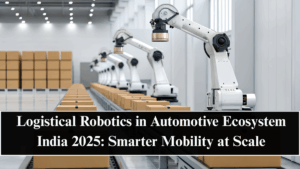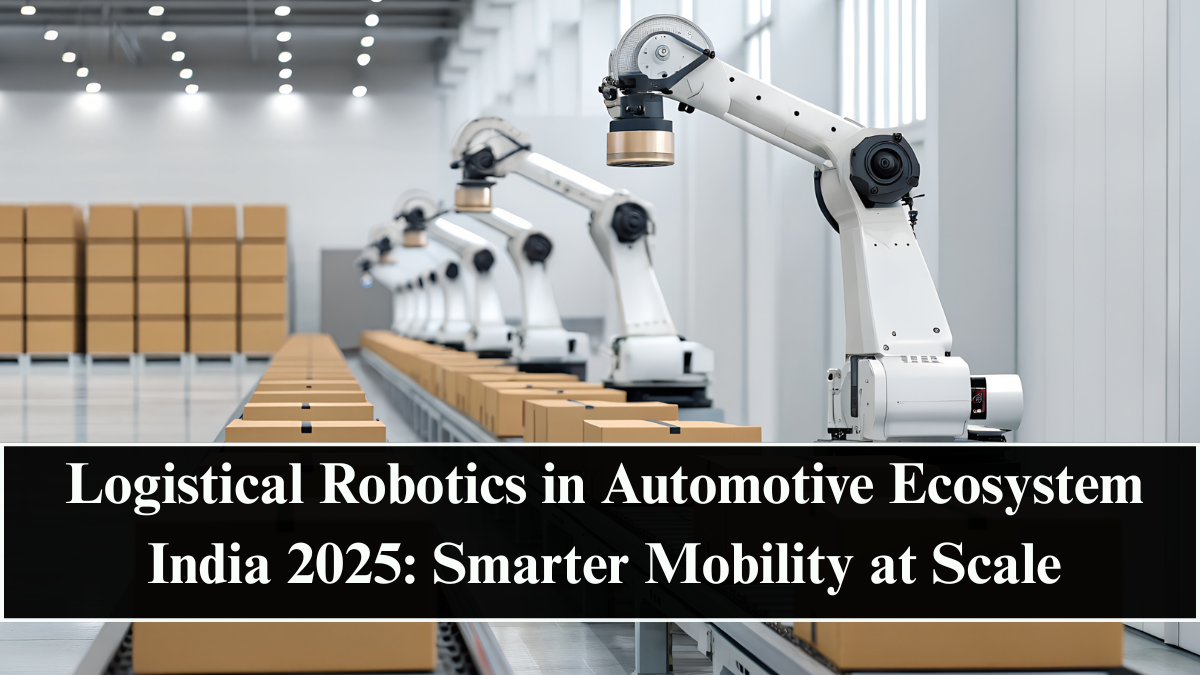The future of logistics is autonomous, and Logistical Robotics in Automotive Ecosystem India 2025 is at the forefront of this transformation. In 2025, India’s automotive and logistics sectors are converging through robotic automation, enabling self-driving delivery pods, autonomous material movers, and intelligent warehouse systems that redefine supply chain efficiency.
With the rapid growth of EVs, connected vehicles, and last-mile delivery services, India’s adoption of robotics is not just futuristic — it’s becoming essential to scale operations, reduce costs, and meet sustainability goals.

The Rise of Robotic Mobility in Indian Logistics
India’s logistics industry, worth over $400 billion, is undergoing massive digital transformation. Robotics in logistics is bridging the gap between traditional vehicle-based movement and AI-driven automation.
In 2025, major automotive OEMs, logistics giants, and startups are deploying autonomous mobile robots (AMRs) and robotic delivery vehicles to handle transportation, warehousing, and distribution with minimal human intervention.
For instance:
-
Tata Motors and Mahindra Logistics are piloting autonomous yard management robots.
-
Amazon India and Flipkart are deploying delivery drones and autonomous pods for faster last-mile solutions.
-
Ola Electric and Ashok Leyland are testing self-driving delivery vans and e-mobility logistics robots for urban supply chains.
How Robotics Is Reinventing the Automotive Ecosystem
The integration of robotics into automotive logistics impacts every layer of the supply chain — from manufacturing to delivery.
Key robotic applications include:
-
Autonomous Mobile Robots (AMRs): For parts movement inside factories and warehouses.
-
Robotic Delivery Pods: Small, battery-powered units navigating urban environments autonomously.
-
Automated Guided Vehicles (AGVs): Used in assembly plants for component transfer.
-
Robotic Loading Systems: Performing loading/unloading tasks with precision.
-
AI-Driven Fleet Orchestration: Optimizing route planning, charging, and vehicle deployment.
These technologies help reduce turnaround times, labor dependency, and carbon emissions — ensuring consistency and scalability in logistics networks.
Technological Enablers Behind the Robotics Revolution
The success of logistical robotics in 2025 depends on a blend of advanced technologies:
-
AI and Computer Vision: Enable object recognition, navigation, and obstacle avoidance.
-
5G Connectivity: Provides ultra-low-latency communication between robots, vehicles, and cloud systems.
-
IoT Integration: Allows real-time monitoring of fleets and warehouse robots.
-
Edge Computing: Ensures faster decision-making locally without relying on central servers.
-
Battery & Charging Innovation: High-density lithium and solid-state batteries enhance range and uptime.
Together, these innovations allow autonomous logistics ecosystems to operate round-the-clock, even in complex environments like ports, airports, and industrial parks.
Benefits for India’s Mobility and Manufacturing Sectors
The shift to robotic logistics provides measurable advantages:
-
Operational Efficiency: Robots optimize movement and eliminate idle time in logistics chains.
-
Cost Reduction: Automation lowers dependency on manual labor and reduces maintenance costs.
-
Safety Improvement: Reduces workplace accidents in warehouses and loading zones.
-
Scalability: Cloud-based systems allow operators to scale fleets rapidly across multiple locations.
-
Sustainability: Electric robots and EV-based fleets reduce carbon footprints and promote clean mobility.
By 2025, companies implementing robotic logistics are achieving 20–30% cost savings and 50% faster fulfillment rates, establishing India as a global logistics innovation hub.
India’s Policy Support and Industrial Adoption
The Indian government’s National Logistics Policy (NLP) and Digital India initiative are catalyzing this change. Incentives for Industry 4.0 adoption and EV ecosystem development are pushing automakers and logistics firms to deploy intelligent robotics at scale.
Emerging industrial corridors in Gujarat, Tamil Nadu, and Maharashtra are integrating smart warehouses equipped with AI and robotic handling systems. These facilities use automated drones, robotic forklifts, and predictive AI software to manage inventories seamlessly.
Private players like Addverb Technologies, GreyOrange, and Asimov Robotics are exporting Indian-designed robotic solutions worldwide, reinforcing India’s reputation as a manufacturing and automation powerhouse.
The Future of Robotic Logistics in India
By 2025, India’s automotive ecosystem will function as a hyper-connected network where vehicles, robots, and infrastructure communicate autonomously.
Expect to see:
-
Autonomous fleet coordination between EVs and delivery robots.
-
Smart charging stations that service both vehicles and AMRs.
-
AI-powered supply chain twins simulating real-time logistics decisions.
-
Drone-assisted deliveries in rural and semi-urban regions.
The result: an ecosystem that’s faster, safer, and greener, powered by robotics and intelligent mobility.
FAQs
What is logistical robotics in the automotive sector?
It refers to the use of robots, automation, and AI in vehicle manufacturing, distribution, and last-mile logistics.
Which industries are adopting logistical robotics in India?
Automotive manufacturing, e-commerce, warehousing, and transportation companies like Tata, Mahindra, and Amazon India are leading adoption.
How do robots improve logistics efficiency?
They automate repetitive tasks, reduce human error, and operate continuously, improving turnaround time and cost efficiency.
What role does AI play in logistics robotics?
AI powers decision-making, navigation, and predictive analytics to optimize routes and manage robotic fleets.
What’s the future of robotics in India’s automotive ecosystem?
By 2030, India will see integrated robotic networks connecting factories, EV fleets, and autonomous delivery systems for seamless, sustainable logistics.
Click here to know more.
